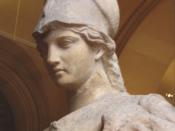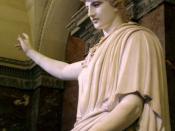The myth of Arachne, which appears in OvidÃÂs Metamorphoses, reveals a lot about the view of women in myth as well as the cultural relationship between mortals and the gods. The first authoritative telling of the tale occurs primarily in the works of Ovid, who is also the only classical source of the myth, though Virgil refers to it in his work, Georgics. As such, OvidÃÂs account in Book VI of Metamorphoses is the standard account, and the way in which Ovid chooses to tell the story is widely regarded as an accurate representation of the original telling (Carter, 163). ArachneÃÂs story depicts females as emotional, but complex, and demonstrates the equally complex relationships that mortals have with the gods.
ArachneÃÂs portrayal is different from the usual portrayal of women in classic myth- rather than being a virginal victim or a jealous lover, Arachne is a boastful, confident (albeit foolish) example of a strong mortal woman.
By contrast, AthenaÃÂs behavior places her firmly in the ÃÂjealousÃÂ category, as she behaves in a pitiless and envious way towards her rival Arachne. The rivalry starts with Arachne, a very talented weaver, and her challenge to the bright-eyed goddess. As well as being the goddess of wisdom and war, Athena is interested in ÃÂwomenÃÂs activities, particularly the domestic arts of spinning and weavingÃÂ (Harris & Platzner, 191), and has an affinity for it. Upon hearing of the bold request, the goddess takes the guise of an old woman and warns Arachne; "seek all the Fame you will among mortal men, but yield place to the goddessÃÂ (Ovid, 6.30). Arachne ignores the warnings and the challenge proceeds. Arachne weaves images of the ÃÂerotic affairs of the godsÃÂ (Luyster, 153). Athena, enraged, destroys the work and begins to beat Arachne. When the ÃÂterrifiedÃÂ girl tries...


